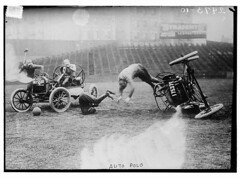US Senate Rejects Auto Bailout
 The US Senate rejected the $14B auto-maker bailout bill approved earlier in the week by Congress. Republicans and Democrats failed to agree to end debate on the bill over union compensation, which the Republicans insisted be lowered to that of those working at Japanese auto makers with plants in the US.
The US Senate rejected the $14B auto-maker bailout bill approved earlier in the week by Congress. Republicans and Democrats failed to agree to end debate on the bill over union compensation, which the Republicans insisted be lowered to that of those working at Japanese auto makers with plants in the US.
The only real hope for GM and Chrysler surviving the year is an emergency bridge loan from the Federal Reserve under the TARP program; $700B set aside to purchase illiquid assets from banks and financial institutions to free up counter-party credit.
A bridge loan under the TARP program could provide enough capital for GM and Chrysler to survive outside of bankruptcy until the next session of Congress and the new President is sworn into office, perhaps changing the political dynamic of passing a revised Bill.
Ford has indicated in hearings before Congress that it was seeking a line of credit facility on which it could draw for emergency working capital. Ford executives said they didn’t anticipate having to use the funds. Ford does not appear to be in immediate need of bankruptcy protection as GM and Chrysler are.
The “big 3” US auto makers have been hit with a devastating 1-2 punch forcing them to the brink. A combination of shrinking demand and credit paralysis have nearly wiped them out.
High fuel prices, a slumping housing market and an absence of consumer credit have all drastically cut demand for new automobiles by as much as 50% compared to the same month a year ago. This drop in demand is universal effecting both US and foreign makes. Mike Jackson, CEO of AutoNation the largest US dealer network, said in an interview with Bloomberg News that auto sales are at ‘depression levels’ and that it could take as long as 5 months to clear out excess inventory already sitting on dealers lots. He went on to say the the approval rate for prime new car loans has fallen from 95% a year ago to just 6%, making financing nearly impossible for even credit-worthy consumers.
The scarcity of available credit has also effected the auto makers who have been unable to refinance debt obligations. They have been paying those obligations with cash leading to burn-rate of $4.4B/month for GM and $7B/month for Ford. It was only in September than GM reported $25B in cash on their books that is now largely gone.
The US auto industry has been suffering a number of “legacy” issues and have been working to restructure them over the past couple of years. The first is the size of their dealer network. The Big 3 simply have too many dealers for their market share which has fallen from 70% to just 30% amidst stronger foreign competition. Dealer franchise agreements prevent them from reducing the network to an appropriate size.
Another ‘legacy’ issue hindering the US auto industry are pension and healthcare obligations to retired and retiring workers, essentially their retirement plans. Before the age of the 401(k) companies used to have pension funds to take care of employees in retirement. Those funds were largely raided and drastically under-funded by companies like GM, Ford and Chrysler for decades which is a debt the automakers are having a hard time swallowing.
Bankruptcy advocates suggest the correct way to deal with those legacy problems is to “restructure” them through a Chapter 11 bankruptcy. They may get their wish.
